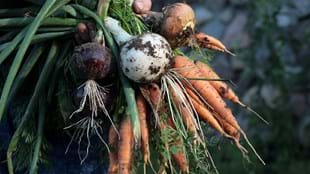The impacts of climate change will be worse than expected, according to the latest IPCC report. With government and industry inaction meaning we’re potentially heading for a permanently heated planet, feeling pessimistic would be an understandable response.
But what about our personal choices? What can we do as individuals to have a positive impact on climate change?
One increasingly popular response to the challenge has been go vegan, with research showing one of the major drivers of the switch to veganism being concern about environmental degradation; raising animals for food is a contributor to rainforest destruction, fresh water overuse and contamination, and climate change. While there is disagreement over exactly how much the meat and dairy industries are to blame, the UN has backed the move to a meat and dairy-free diet, arguing that a global shift towards veganism was vital to avoid world hunger and help the planet.
The number of people opting for an animal product-free lifestyle has skyrocketed in the last decade, helped along by celebrities, athletes, and the plant-based movement. The trend is strongly powered by Instagram – someone uploads a post tagged #vegan every three seconds.
Unfortunately, sharing your vegan meal on social media won’t necessarily have much impact on your carbon footprint. Although grain-fed meat and industrial farming practices are a major environmental and health issue, here’s the dirt on veganism: if the growers of the soy, corn, wheat, vegetables and fruit you’re eating aren’t focused on building soil health – and therefore storing carbon – the production of those foods is still contributing a significant amount of carbon dioxide to the atmosphere through poor soil practices.
The world’s soils hold about twice the amount of carbon found in the atmosphere and in vegetation. Good, deep, undisturbed soil and vegetation holds on to carbon, whereas soil exposed to the air – such as through regular seasonal tilling – means carbon dioxide is released into the atmosphere. And it’s more than you might expect: organic carbon loss from soils has been estimated to equal about one-sixth of annual fossil fuel-induced carbon emissions. A warmer Earth would cause soil to release more carbon, making the problem worse.
But with better soil management, such as is central to regenerative agriculture, it’s possible to transform farms that emit carbon into farms that actually suck it out of the atmosphere and keep it in the soil – a practice known as “carbon farming”. A long-term study of an Australian wheat farm found that various carbon farming practices such as cultivation, stubble management and crop rotation had a huge impact on carbon dioxide release into the atmosphere. Growing clover between crops, not burning the wheat stubble, and avoiding tilling the soil, meant the study area’s loss of 400kg of carbon per hectare per year not only reversed itself, but actually turned the farm into a carbon vacuum instead, sequestering 185kg per hectare per year.
It takes 272 liters of water to grow two or three medium-sized avocados, and their popularity in the West is fueling illegal deforestation in countries that supply them.
Monocrops – rows and rows of the same plant, such as soy, wheat and corn – contribute little to a healthy soil ecosystem that includes insects, invertebrates, birds, worms, and bacteria that fight pests and disease.
There’s also the issue of popular imported ingredients such as avocados, almonds, and “Himalayan” pink salt which, when they suddenly become globally hyped, can have their own environmental and social impact on the communities that produce them, as well as a heavy carbon footprint.
The mania for avocados is causing increased deforestation in Mexico, and greater demands on water in Chile and Northland, New Zealand. Australian food warrior Sarah Wilson points out that it takes 272 liters of water to grow two or three medium-sized avocados, and their popularity in the West is fueling illegal deforestation in countries that supply them. She recommends consuming them as a delicacy and eating just a quarter a day. The popularity of almonds and almond milk is also straining water resources in California, which produces 80 percent of the world’s supply.
Meanwhile, that pretty pink salt is a non-renewable resource that is mined conventionally in Pakistan (not in the Himalayas), with the associated environmental impact, as well as tens of thousands of food miles involved in getting it to market.
The best choice for “superfoods” are the cheap, familiar ones you can grow yourself or buy locally: local sea salt, beetroot, garlic, cauliflower – and yes, kale.
So if you’ve turned vegan for both environmental and animal welfare reasons, it makes sense to find out where that tofu is coming from and what its soybeans did to the land. Were those beans grown in a monoculture, where the land is regularly tilled, and no cover crops are used between harvests? Or were they grown on a farm that focuses on soil health and actually captures carbon from the air rather than releasing it?
Simply looking for organic produce is not necessarily the answer either. While both organic and permaculture growing practices avoid industrial pesticides and fertilizers, permaculture goes beyond organic to close the nutrient, water and waste loop as far as possible. The no-dig principles of permaculture build healthier soil, sequestering carbon. The system has a focus on grouping beneficial plants together, and includes animals in the growth and regeneration cycle. A certifiably organic farm can still practice monocropping, excess soil tillage and carbon release, water wastage, and sprays and compounds that can kill helpful insects along with pests – all of which genuine permaculture eschews.
Eating the most environmentally sustainable diet may turn out to include animal products after all. Farmer-turned-writer Isabella Tree highlighted this in her 2018 book Wilding. With her husband she runs a 1400 hectare farm in West Sussex, England. Economically unsustainable due to its poor, clay-heavy soil, nature was left to take its course. Animals were reintroduced and the land left largely alone – and diversity and wildlife flourished. The poor agricultural land became a functioning, food-producing ecosystem once more, with rare and common plants, animals and insects returning to enrich the biodiversity.
Crucial to the process were the animals: naturally roaming herds of longhorn cattle, Exmoor ponies, Tamworth pigs and red deer, who live out in the open, give birth without intervention, and whose teeth, hooves, trotters and dung encourage grass growth, rare plants, bacteria, fungi, insect and bird life – a “glorious mess”, as one reviewer described the results of Tree’s pastoral battle against “the English addiction to tidiness”.
It suggests that eating moderate amounts of ethically-produced, local, grass-fed meat and dairy, along with local vegetables and fruit grown using permaculture principles, may be the best answer to the challenge of sustainably feeding ourselves.
But that’s not always easy or affordable – or even possible. As consumers we need to ask why. The bottom line is that we all need to know where our food is coming from, what is used to produce it, and how it is farmed or grown. If we don’t know, why not? And if it turns out to be grown in a way that is destructive and unsustainable, how can we change that, and which farmers and growers can we support and promote instead?
Consumers can force change, as we’ve seen recently with products once as seemingly ubiquitous as the plastic straw. Soil health is vital to the future of our food supply, and to the future of our warming planet. We all need to take a minute to ask retailers, companies, and farmers: “How was this grown?”
Naomi Arnold is a New Zealand-based author and writer specializing in environmental and health issues.
If you want more tried, tested and true news from the leading edge of health and fitness sign up to get Fit Planet insights and advice straight to your inbox.








